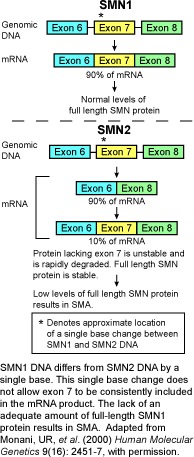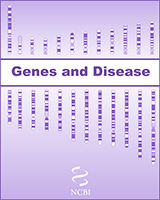NCBI Bookshelf. A service of the National Library of Medicine, National Institutes of Health.
National Center for Biotechnology Information (US). Genes and Disease [Internet]. Bethesda (MD): National Center for Biotechnology Information (US); 1998-.

Death of spinal motor neurons and subsequent muscle paralysis characterize Spinal Muscular Atrophy (SMA), a hereditary neuromuscular disorder that is the most common genetic cause of childhood fatality. The age of onset and severity of SMA varies from an infantile onset form (type I) which causes early death from respiratory failure, to milder juvenile onset forms in which affected individuals show reduced life expectancy (type II), and are unable to walk (types II and III).
Expression of the disease requires mutation of both alleles of the survival motor neuron gene (SMN1) found on chromosome 5, making SMA an autosomal recessive disorder. Typically, the mutations are caused by a deletion within SMN1, or when the SMN1 gene is replaced by an almost identical gene called SMN2, also located on chromosome 5. Both SMN1 and SMN2 code for identical proteins, but the SMN1 gene produces the full-size protein, whereas the SMN2 gene produces truncated versions of the protein, and a small amount of the full-size protein. Deletions within both copies of the SMN1 gene results in type I SMA, whereas the milder forms of SMA usually occur when SMN1 is replaced by SMN2, increasing the number of copies of SMN2. The more SMN2 genes an affected individual has, the more full-length protein will be produced, and the milder the resultant form of the disease. The protein encoded by SMN1 and SMN2, which is known to play a crucial role in the production of mRNA, is expressed throughout the body, but is found in especially high levels within the spinal motor neurons.
The function of SMN1 is currently being investigated by studies in rats and transgenic mice. It is hoped that the characterization of this protein and its function will eventually lead to a therapy that may be used in conjunction with genetic testing already in place to help control the incidence and/or severity of SMA.
Related diseases
- Genome view see gene locations
- Entrez Gene collection of gene-related information
- BLink related sequences in different organisms
- Research articles online full text
- Books online books section
- OMIM catalog of human genes and disorders
- GeneReviews a medical genetics resource
- Spinal Muscular Atrophy Foundation raises funds for SMA research
- Families of Spinal Muscular Atrophy supports families affected by SMA
- OMIMRelated OMIM records
- Spinal muscular atrophy - Genes and DiseaseSpinal muscular atrophy - Genes and Disease
Your browsing activity is empty.
Activity recording is turned off.
See more...
